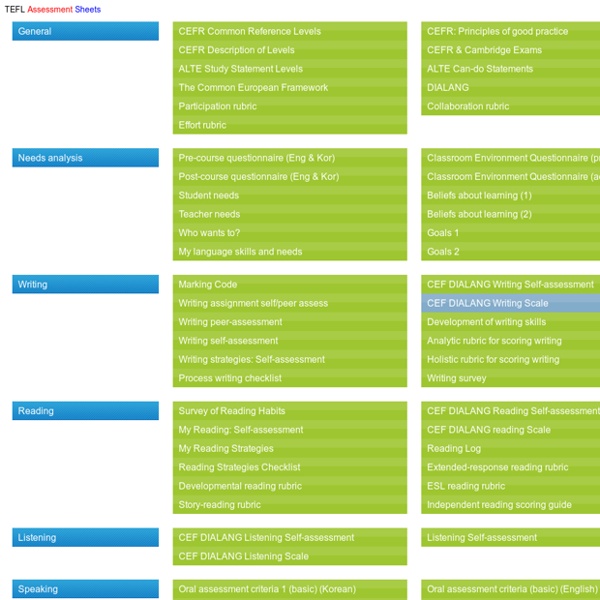



Litz - Student-directed Assement in ESL/EFL: Designing Scoring Rubrics with Students The Internet TESL Journal David LitzUAE University (Al-Ain, United Arab Emirates)davidralitz(at)yahoo.com Introduction This paper will discuss and provide a useful example of "negotiable contracting" (Stix, 1997), an innovative assessment approach in ESL whereby students are actively involved in the construction or creation of rubrics prior to undertaking more complex language learning tasks. It will be demonstrated that the art of negotiable contracting not only empowers students by giving them shared ownership of their own learning and assessment but it also provides them with additional opportunities to use the target language as they analyze and discuss the rubric construction process, examine the rubrics and their different levels, generate descriptive language from the rubric's criteria, and suggest revisions for improvement based on criteria in the rubric. What Are Rubrics? Rubrics can be either holistic or analytic. Designing Scoring Rubrics with Students Empowering Students
edutopia Videos can be an effective tool for teaching and learning English (or, for that matter, any academic subject) if used strategically and not as a "babysitting" device. My colleague Katie Hull Sypnieski and I wrote a previous post for Edutopia titled Eight Ways To Use Videos With English-Language Learners that shares instructional strategies for many kinds of clips. Here are a few of my favorite videos to use with those exercises. Video Playlist: Resources for English-Language Learners Watch the player below to see the whole playlist, or view it on YouTube. Mr. More Resources on How to Teach ELLs With Video For more sources of good videos designed for English-language development, and for ideas on how to use them, visit these websites: The Best Popular Movies/TV Shows For ESL/EFL (& How To Use Them) is an exhaustive collection that I've developed.
Rubric Tutorial Creating a rubric is easy once you have taken to time to evaluate the dimesions/tasks which make up the students performance, and the criterion you will use to evaluate it. That being said, let’s begin with the steps to create a rubric. The steps to create a rubric are listed in sequential order, however they can be performed in any order as long as the rubric contains the following: -Performance Objective -List of dimensions to be evaluated -Levels of gradation of quality -Criterion and points for each level of quality We have divided the task of creating a grading rubric into 6 steps: 1. Step 1: Record/write the performance objective. Performance objectives should consist of 3 elements: -- Student Performance -- Conditions -- Criteria The Student performance is the observable behavior that a student will do to demonstrate that the lesson is learned. Below is an example of a performance statement without the criteria. Step 2: Identify the dimensions/tasks comprising the performance.
Everything Teachers Need To Know About Bloom’s Taxonomy Bloom’s Taxonomy is one of the most important frameworks that has certainly changed education. Bloom’s Taxonomy refers to a hierarchical ordering of cognitive skills that, inter alia, is used by teachers to support students’ learning. This framework can be used to plan lessons, develop peer and self-assessment, design and evaluate teaching materials, learning and instructional design, plan learning objectives, plan students’ projects…..etc. Historical background of Bloom’s Taxonomy The evolution of this Taxonomy dates back to 1956 when Benjamin Bloom, Max Englehart, Edward Furst, Walter Hill, and David Krathwohl published a framework for classifying educational goals entitled Educational Objectives Taxonomy or Taxonomy of Educational Objectives. Bloom’s taxonomy included six major levels: knowledge, comprehension, application, analysis, synthesis, and evaluation. The original Bloom’s Taxonomy (1956) The original version of Bloom’s Taxonomy includes six categories. RecognizingRecalling
AulaBlog La Mansion del Ingles. Curso de Ingles Gratis. Gramática inglesa EFL Educators - THE TRAITS OF AN EFFECTIVE READER Arrasmith, Dean, and Kevin Dwyer. “The Traits of an Effective Reader.” Journal ofSchool Improvement. 2.2 (2001) When readers acquire these traits, they are able to: - read the lines, between the lines, and beyond the lines - process knowledge, make sense of it, and transfer it to other situationsThese traits are hierarchical; they range from literal to high critical thinkingREADING THE LINES 1.
Materiale didattico di inglese per scuola secondaria | Pearson Risorse di qualità per l'insegnamento dell'inglese: teaching resources I materiali didattici Pearson in inglese combinano la conoscenza della grammatica e della sintassi con l'uso della lingua nella vita di tutti i giorni, offrendo dunque un quadro completo per l'insegnamento dell'inglese nella scuola secondaria. Con gli strumenti a tua disposizione, potrai aiutare gli alunni ad arricchire il proprio vocabolario e conoscere le origini e il significato delle espressioni idiomatiche più utilizzate, imparare le tradizioni della cultura inglese ma anche leggere testi e articoli ricchi di curiosità interessanti, studiare la letteratura in maniera altamente coinvolgente e conoscere le principali città del Regno Unito e USA. Le risorse Pearson per l'insegnamento dell'Inglese rappresentano un ottimo strumento per venire incontro alle necessità di docenti e studenti, unendo gli aspetti nozionistici con il piacere di imparare a comunicare correttamente con gli altri in un'ottica globale.
Assessment: Lower Stakes, Raise Retention Assessment is a hot-button issue in today's K-12 education landscape, especially when one places the word "standardized" in front. But not all tests and exams need raise hackles or blood pressure. Indeed, there is a certain kind of exam that has been shown to increase learning in the classroom without undue dread: low-stakes assessment. Retrieval-Enhanced Learning Henry Roediger III, professor of psychology at Washington University in St. New York Times science writer Benedict Carey, in his book How We Learn (2014), explains why this kind of low-stakes testing, as Roediger puts it, "serves students best" -- answering questions aids in retention. Pooja Agarwal, a postdoctoral fellow at WUStL who oversees such retrieval-enhanced learning (researchers began by calling their studies "test-enhanced learning" but found that word too incendiary for teachers) at a school district in Illinois, points to another positive outcome: 8 Low-Stakes Suggestions 1. 3. 4. 5. 6. 7. 8. Embedding and Retrieval